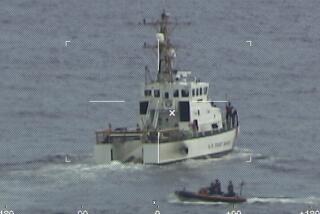ISLAND IN THE STREAM
- Share via
ALICE TOWN, Bahamas — When I was a teenager more than 30 years ago, I went to Bimini for the first time with Gregory Hemingway, one of Ernest’s sons, who was my brother-in-law. Although Ernest Hemingway often fished in Key West and Cuba in the ‘40s and ‘50s, another of his favorite spots was the waters off this pair of small islands in the Bahamas. Greg was a serious fisherman, and he showed me how to bait hooks, just as his father had taught him.
On that trip Bimini became a magical place for me. It was close to Miami and yet a whole different world. And so began my long love affair with Bimini. Since then I’ve been back at least 20 times.
Last August it was time to introduce my new wife, Galina, to Bimini’s appeal. She’s from Russia, and I wasn’t sure if she would appreciate the islands as I do. I jokingly told her that if she did, it would be a sign that our marriage would last forever.
We arrived in Miami and spent the night at a budget-priced motel after finding a restaurant with tasty Cuban food. The next morning, after a jolt of Cuban coffee, we caught our flight to Bimini.
Getting there from Florida is easy, since Bimini is only about 50 miles east of Miami. And getting there is half the fun; Pan Am Air Bridge flew us there in a vintage 18-seat amphibious plane. At check-in our baggage was weighed carefully to make sure the plane wasn’t overloaded. On this tiny tropical airline, the regulation pilot’s uniform consists of blue Bermuda shorts, short-sleeved shirt, sunglasses and boat shoes. After all, during this time of year island temperatures can hover in the 90s, and the humidity is about 80%.
After just a short time into the 20-minute flight, Galina and I were scanning the horizon for the distinctive Bahamian waters. Soon the plane banked gently and slowed for its landing in the bay that separates North and South Bimini islands. After a gentle skip across Bimini Bay, the landing gear was extended and the old seaplane lumbered up the ramp onto North Bimini. We could have taken one of the island’s taxis after our five-minute stop at the tiny customs building, but it was just as easy to carry our bags the three or four blocks to any of the hotels in little Alice Town, where most visitors to the north island stay. For this trip I’d made reservations at the Bimini Big Game Fishing Club. It’s relatively pricey, but I wanted to treat my wife to the island’s nicest place.
Before checking in we stopped at the Sand Bar, an old place no bigger than your average living room, where we met an American Airlines pilot and his girlfriend, who had sailed to the island on his boat. They invited us to come aboard one night for cocktails. Then, as Galina and I continued on down Alice Town’s main street, we stopped to chat with old friends of mine, including Bob Smith, the captain of a fishing boat I’d chartered a couple of times.
Hotel accommodations in Bimini vary from first class to very simple. At the Bimini Big Game Fishing Club, double rooms start around $195 (including tips and taxes), and we stayed in a first-floor room that opened onto a beautiful tropical garden--which Galina loved. But this is a sporting paradise, so when we entered our room, instead of finding traditional closets, we saw racks to hold fishing rods and scuba-diving tanks.
That day I filled Galina in a little on island history. Ernest Hemingway often visited Bimini because it was near one of his favorite Gulf Stream fishing grounds. His novel “Islands in the Stream” is partly set here. Bimini’s colorful past includes pirates, smugglers and devastating hurricanes, but these days its relaxed pace centers on big game fishing and diving.
What makes Bimini a great fishing center is both the size of the fish and their variety. In Bimini a 300-pound blue marlin is considered a good catch, although marlin weighing more than 1,000 pounds have been caught here. And in late spring, 600-pound tuna pass close to the islands. It takes a large fishing boat equipped with hoists or block-and-tackle rigs to bring these fish aboard. Local charter boats can run from $500 to $900 a day, although during midweek I’ve found the rate more negotiable.
Right after our arrival, we discovered that Hurricane Bonnie was brewing in the northeastern Bahamas (the hurricane season in these parts generally starts in late summer and lasts through October). Storm warnings were posted, and many fishing boats made the crossing back to the Florida mainland. Some other fishing boats were willing to take us out, but with the hurricane-generated swells reaching six feet, I didn’t want Galina to be bouncing around all day. So our deep-sea-fishing plans would have to be deep-sixed.
Surrounded by reefs, Bimini is the final resting place for countless ships. I wanted to rent a boat for the day and show Galina the “concrete ship,” a World War I-era vessel that had run aground. But by now the hurricane was whipping up even the protected waters of Bimini Bay. It was interesting to watch how people reacted to the possibility of a major hurricane. Tourists, especially first-timers, wondered if they could catch the next seaplane back to Miami. The locals, however, accept hurricanes as part of their routine.
Despite Bimini’s small size, I knew there was much to explore on land too. We casually walked the small side streets of Alice Town. There are only two main streets, and the 1,500 or so full-time residents of the islands are concentrated near the southern tip of North Bimini. (South Bimini is nearly deserted.)
Bimini features beautiful beaches, and midweek we had North Bimini’s west-facing beaches all to ourselves. Here the offshore reefs keep the waves down, and with mask and fins we were able to snorkel around a reef no more than 20 yards from shore. The water temperature, about 80 degrees, was so pleasant that we didn’t want to get out.
One day, after lunch, we visited Bimini’s straw market in Alice Town. I remembered it as a place where long ago you could watch the locals weaving straw products. Now it’s more of a kitschy tourist market, where we bought some souvenir T-shirts. Still, it was interesting because of the constant banter among women vendors sharing the latest island news and gossip. Galina and I lingered, eyeing the same items over and over again just so we could listen.
After a few days we fell into Bimini’s unhurried rhythm. The twice-daily arrival and departure of the seaplane became a clock for us (we could hear the engines from anywhere on the island), while the horn blast from the ferry to South Bimini told us it was noon. Around 3 p.m. it would rain for half an hour. And then the charter fishing boats would return at about 5 p.m. with their catch.
When I was young I often stayed at the Compleat Angler Hotel, and I was eager to show Galina the place. The locals say the hotel was constructed from the wood of wrecked ships, and Ernest Hemingway often stayed here. Gregory Hemingway had once pointed out to me the second-floor rooms where he stayed with “Papa” on their trips to Bimini. A section of the hotel’s first floor is now set aside as a Hemingway museum. Although we could have rented a room in the hotel, the downstairs bar has become the island’s main nightspot, and it can be quite loud if you’re trying to sleep.
There’s only a handful of old-standby restaurants in Bimini, so I took Galina to all of them, and since it was midweek we often found we were the only people eating. Her favorite meal was the one we had at the Bimini Blue Water Resort’s restaurant, which sits atop the island’s highest point, a whopping 20 feet or so above sea level. The place offers a dazzling sunset view of the Atlantic and nearby Gulf Stream, and the prices are reasonable, with dinners averaging $12 to $15 per person, excluding drinks. We had some conch chowder and fresh grouper. Another night we had dinner with the airline pilot and his companion at the Red Lion Pub, where I had a great double lobster tail for about $18.
Galina quickly learned that in Bimini one should never be in a rush; they’ll bring your food when they “get around to it, mon.” While waiting for dinner, we sampled Kalik, an excellent Bahamian-brewed beer.
In the evenings, the Compleat Angler often features a local steel-drum band. One night we came in as they were starting to play. There was a big crowd; it seemed like everyone we’d met that day was present. But we preferred some quiet, so we left for a long walk.
With the hurricane threat fading, the gentle Atlantic breeze felt as intoxicating as the rum punch being served inside the noisy nightclub. The glow from the harbor boats and the moon overpowered the few dim lights along the empty street. The only sound came from the distant clatter of sailboat rigging and an occasional barking dog. For the true allure of Bimini lies in its simplicity and isolation.
(BEGIN TEXT OF INFOBOX / INFOGRAPHIC)
GUIDEBOOK
Hooked on Bimini
How to get there: There are no direct flights to Bimini; connections are through Miami or Fort Lauderdale, Fla. To Miami, American and United fly nonstop; Northwest flies with one stop. Round trip fares start at $294. To Fort Lauderdale, American flies nonstop; Delta offers a direct flight with one stop. Round trips start at $288. Pan Am Air Bridge flies from Fort Lauderdale or Miami to Bimini, $81.50 one way.
Where to stay: Bimini Big Game Fishing Club, P.O. Box 699, Bimini, Bahamas; telephone (800) 737-1007. Doubles $195 per night, cottages $228, penthouses $343.
Compleat Angler Hotel, P.O. Box 601, Bimini; tel. (242) 347-3122. About $68 single, $70 to $73 double, $83 for two double beds. Warning: The nightclub is noisy.
Sea Crest Hotel, P.O. Box 654, Bimini; tel. (242) 347-3071. About $88. More like an upscale Motel 6.
For more information: Bimini Tourist Office, tel. (242) 347-3529.
More to Read
Sign up for The Wild
We’ll help you find the best places to hike, bike and run, as well as the perfect silent spots for meditation and yoga.
You may occasionally receive promotional content from the Los Angeles Times.






